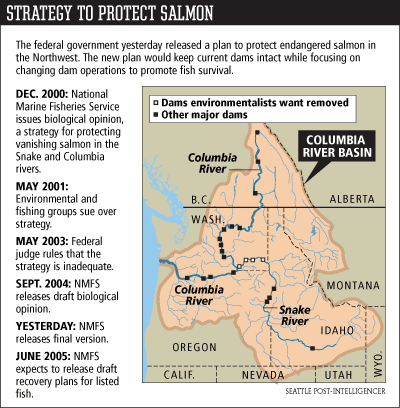forum
library
tutorial
contact

Dropping Dam Removal from Recovery Plan
Angers Critics
by Lisa Stiffler
Seattle Post-Intelligencer - December 1, 2004
|
the film forum library tutorial contact |

|
Dropping Dam Removal from Recovery Planby Lisa Stiffler
|
When the federal government unveiled its plan for saving Northwest salmon four years ago, environmentalists panned it.
But the $6 billion blueprint released yesterday -- in response to a court order to improve it -- is even worse, they contend.
The critics are angered by the government's decision to drop dam-removal as a potential means of saving salmon and steelhead in the Columbia and Snake rivers protected under the Endangered Species Act.
"This plan represents a total failure of leadership and is a crushing disappointment to the people of the Northwest," said Jan Hasselman, an attorney with the National Wildlife Federation, the group that's led legal challenges to the federal salmon strategy.
 Hasselman and other environmentalists vowed yesterday to take the new plan to court.
Hasselman and other environmentalists vowed yesterday to take the new plan to court.
Government officials admit the dams can harm fish, but defend the plan, saying it's legally and scientifically sound -- and just one piece of a multifaceted effort to keep the iconic fish from disappearing.
The strategy "provides a foundation of recovery," said Bob Lohn, Northwest regional administrator with the National Marine Fisheries Service. "This is not the totality or even the majority of our actions."
To explain the plan, Lohn was joined in a conference call yesterday by officials with the Bonneville Power Administration, which sells the power generated by 31 federally owned dams, the U.S. Army Corps of Engineers and the U.S. Bureau of Reclamation.
The strategy focuses on altering operations of eight major dams on the Columbia and Snake to reduce the number of juvenile fish getting killed.
Salmon sometimes get chopped up in hydropower turbines. Other fish are harmed by increased water temperatures in reservoirs above dams. Still others are injured when they are shipped in trucks past the dams and released downstream.
Lohn argued it was inappropriate for the fisheries service to look at removing dams, saying the issue is how best to operate the facilities.
| Average (1994-1999) | |||
|---|---|---|---|
| Direct Mortality | Fall Chinook | Spring Chinook | Steelhead |
| Columbia/Snake Dams (Mortality from 8 dams)
| 12% | 20% | 17% |
| Columbia/Snake Reservoirs (Mortality from 8 reservoirs)
| 81% | 40% | 41% |
| Indirect Mortality | ? | ? | ? |
-- National Marine Fisheries Service, December 21, 2000 (more)
The 10-year plan calls for construction of "fish slides" that funnel juvenile fish to passages deep below the dams that bypass the turbines. One of these slides has already been built at one of the Snake River dams and a similar device exists on the Bonneville Dam. The government intends to build the slides, also known as weirs, at the other dams.
The federal plan would also boost salmon survival by reducing predation by Caspian terns, increasing the amount of water spilled through dams in the spring and boosting habitat-restoration efforts in shallow and marshy areas.
The plan "is of enormous consequence ... to the people in the Northwest," said BPA Administrator Steve Wright.
It affects 12 runs of chinook, steelhead, chum and sockeye listed as either "endangered" or "threatened," plus one run of coho proposed for listing.
The fish populations have dropped dramatically from historical levels. In recent years, ocean conditions that were rich in nutrients and short on predators gave a boost to salmon numbers.
"Overall populations ... are doing very well," said Brian Gorman, a spokesman for the fisheries service. "But biologists know perfectly well that this is cyclical, and they also know perfectly well that much of the good news comes from good ocean conditions."
Environmentalists critical of the government plan worry that when less favorable conditions return, the plan won't do enough to save the salmon. They argue that removal of four Snake River dams is the best bet for the survival of the fish.
"We want salmon recovered to ... self-sustaining levels," said Michael Garrity of American Rivers, an environmental group. "However we get here is fine with us. Dam removal has been shown to be the only measure that has been proven to get to that goal. We still think that's necessary."
The new plan is part of a lengthy biological opinion that is the federal government's answer to a lawsuit brought by the National Wildlife Federation, American Rivers and 14 other environmental and fishing groups. Numerous tribal groups also supported the suit.
The earlier version of the biological opinion was released in December 2000. In May 2003, U.S. District Judge James Redden in Portland ruled that the strategy didn't do enough to protect the fish.
The judge now could determine on his own whether the new plan is adequate, or the original plaintiffs could request that he make a ruling. The environmentalists could also file a new lawsuit.
Federal officials said they will be releasing more far-reaching recovery plans for the salmon next summer. recovery plans would build on what's in the biological opinion. Those who support keeping the dams were pleased yesterday with the direction the government is heading.
"We've made a lot of progress over the last several years," said Glen Vanselow, executive director of Pacific Northwest Waterways Association, a trade group whose members include ports, transportation and trade interests.
"The idea of looking again at taking out dams is divisive and it takes away from actually solving the problems," Vanselow said. "This focuses the region on recovery actions that can be taken now."
learn more on topics covered in the film
see the video
read the script
learn the songs
discussion forum
